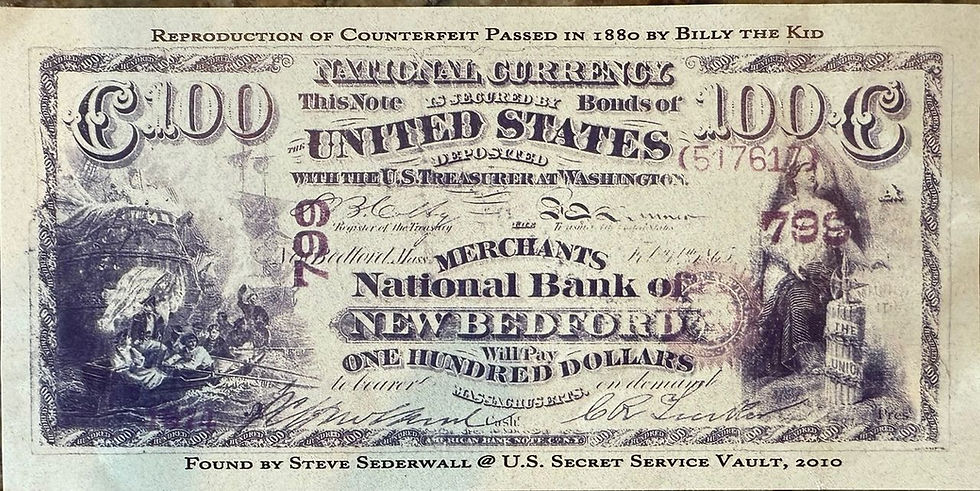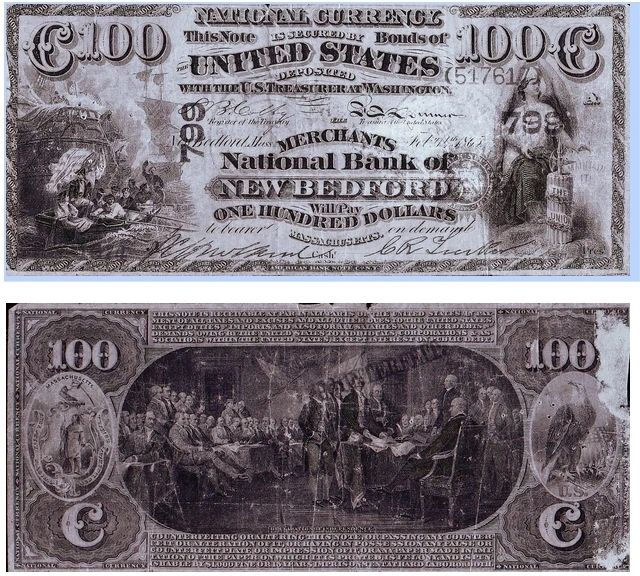HUGH BECKWITH AND THE MURDER OF WILLIAM "BILL" JOHNSON
- jeremiahslatten
- Feb 4, 2023
- 8 min read
By Ben Doss
In early 1849, Henry “Hugh” Mercer Beckwith was thirty-two years old and arrived in Santa Fe after farming for over ten years with his brother, Dr. Jonathan Beckwith, in Florence, Alabama. Shortly after arriving in the territory, Beckwith made friends with two very prominent Spanish families in Galisteo, twenty miles south of Santa Fe, named Rascón and Piño. Beckwith ended up courting a beautiful sixteen-year-old named Refugia W. Rascón y Piño. Refugia’s uncle, Don Pedro Piño, possessed the largest sheep ranch in northern New Mexico. On December 22, 1849, Hugh Beckwith married Refugia and by 1860, the Beckwith’s were listed in the census as being one of the two leading farmers and ranchers in the area, with fifteen employees and real estate valued at $10,000 and personal property of $8,000. They had herds of cattle and sheep and raised smaller crops such as wheat, corn, oats, beans, and potatoes, which they sold to the army at Fort Stanton as well as the Mescalero Apache Indian agent. However, when the Civil War ignited, the Beckwith’s lost everything. Beckwith was a passionate southern sympathizer and lent his aid to the Confederates in their attempted takeover of New Mexico. He was pursued as a traitor to the Union cause and him and his family were forced to leave for the El Paso area in 1862. The Beckwith’s abandoned their farms, livestock, and crops; all confiscated by the Union army.
Once the Civil War ended, Hugh moved his family back to Lincoln and by 1870, the family acquired farmland near Missouri Plaza. The Plaza boasted an intricate community of farmers on the Rio Hondo, thirty-five miles east of Lincoln and fifteen miles west of the new settlement of Rio Hondo (later named Roswell). By this time, the Beckwith family had grown to three boys and four girls. The three boys were Robert 21, John 15, Nicolas 1, and the four girls were Camelia 12, Josephine 9, Helen 7, and Elizabeth 3. Some time in 1872, after increased farming diminished the water on the Hondo, the Beckwith family located a ranch house approximately three miles north of the village of Seven Rivers, where Lakewood now stands. While there is no direct evidence that the Beckwith’s were involved in the Horrell War of 1873, young Robert Beckwith had the unfortunate privilege of meeting them. On the road between Roswell and Seven Rivers, four of the Horrell clan robbed Robert Beckwith and stole his horse and pistol. In addition, the Tejanos helped themselves to eight horses and mules from the Beckwith ranch.
THE ARRIVAL OF WILLIAM HARRISON (BILL) JOHNSON
By the early Spring of 1875, the Beckwith’s had prospered once again; their longhorn herd increased to about 1500 head. It was about this time that William Harrison “Bill” Johnson arrived in Seven Rivers with his partner, John Wallace Olinger. One day, brothers Robert and John Beckwith brought home an injured Johnson, who’d been attacked by Comanches. The encounter took place on the east side of the Pecos, below the present city of Carlsbad at Lone Tree Bluff, just below Loving’s Bend. When the attack began, Johnson and Olinger became separated, and Johnson took a bullet that passed through both of his calves. He hid in the brush and rocks until morning, and then waded across the river to the north. The next day, the brothers discovered Johnson south of their ranch and took him home. The Beckwith women nursed Johnson back to health, and in the process, Johnson fell in love with the oldest daughter, Camelia. In further months, despite the violent protests from her father Hugh, who objected because Johnson was an officer in the Union Army, Camelia married William Johnson on December 25, 1875, at the church in Santa Fe. The two older Beckwith boys built their sister and new brother-in-law a home close by, and in partnership with John Wallace Olinger, Johnson acquired a ranch called the JA6. They ranged from the Penasco River south for seventeen miles to Seven Rivers. The Beckwith cattle carried the brand of "RB" and were blended with the Olinger-Johnson cattle. In 1877, Robert ‘Bob’ Olinger, Wallace Olinger’s brother, arrived from Oklahoma Territory and joined the Olinger-Johnson partnership. On April 25, 1877, Camelia and William Johnson had a son named William E. Johnson.
AUGUST 17, 1878- THE MURDER OF WILLIAM “BILL” JOHNSON
After the final battle in Lincoln on July 19, 1878, which resulted in the death of Hugh's oldest son Robert Beckwith, the violence in Seven Rivers was just rising to the surface. It is Lincoln tradition that when Hugh Beckwith lost his oldest son Robert, he was devastated and blamed his son-in-law William Johnson for getting Bob involved in the fight. Hugh had never liked Johnson and they quarreled constantly. After the Big Killing in Lincoln, Beckwith came to hold Johnson responsible for the death of his son. As Susan McSween said, “Beckwith did everything to keep his boys out of the Lincoln troubles, but Johnson overpowered him and got them on the last trip when “Bob” was killed.” Beckwith festered for nearly a month after his son’s death, then he exploded with a random act of violence. What transpired next was set forth in a letter written by Hugh’s wife, Refugia Beckwith and her son John on the day of the murder.
“We have to inform you that Hugh M. Beckwith shot and killed Mr. W.H. Johnson, the husband of his daughter, on the 17th day of August. The killing was premeditated and without provocation as can be proven. The circumstances are these. Mr. Johnson, Wallace Olinger, W.A. Alexander and A.R. Bennett were stringing some snap beans in the yard of the house, when Mr. Johnson started to go to his room & on his way had to pass by a small adobe house. Just as Mr. Johnson passed the house H.M. Beckwith come out of his room with a double-barreled shotgun loaded with buck shot and fired one barrel into Mr. Johnson killing him almost instantly. H.M. Beckwith then aimed the other barrel of his gun at Wallace Olinger, but Mr. Olinger shot him first in the face. We then disarmed H.M. Beckwith and placed him under guard. We sent him up to be tried by the law & to suffer whatever penalty the law may impose, though he is the husband of one of us and the father of the other.”
The August 31, 1878, edition of the Las Vegas Gazette reported the gunfight as follows:
The Seven Rivers Tragedy. We are allowed to copy from a private letter the following, It is from an eye witness and a reliable source: “It was on August 16th, I think, that old man Beckwith, at his ranch, Seven Rivers, shot and killed his son-in-law, Wm H. Johnson. His weapon was a double-barreled shotgun, loaded heavily with slugs and pistol balls, The charge took effect in the shoulder, neck, and breast and killed the victim instantly. Beckwith then attempted to kill his son, John Beckwith, and was restrained with the greatest difficulty. During the struggle Wallace Olinger shot Beckwith through the cheek and nose with a revolver. Beckwith was arrested and started, under guard, to Fort Stanton. Family affairs are the cause of the difficulty.
The Sheriff assigned to the Pecos River country, Abnath McCabe, arrested Beckwith and drove him 100 miles in a wagon to the army hospital at Fort Stanton. Wallace Olinger easily surrendered to McCabe and rode with them. He was released after being detained for a short time. Dr. Appel, the post surgeon, wrote a letter to Colonel Dudley informing him that Beckwith’s wounds were serious and would die without medical attention. Once Hugh was healed, there was a small dilemma. The military decided they had no jurisdiction and that it was a matter for civil authorities to handle. However, McCabe argued that Lincoln County’s present condition was vile. They “had no jail, no jailor, no funds, and no means to prosecute." McCabe released Hugh Beckwith on September 18, 1878. By 1884, Hugh was in Presidio, Texas, advertising his brand, “RB,” in the Presidio County News. Beckwith acquired a general store there, and was seventy-three years old in 1890, when he met a violent end of his own. On February 2, 1890, Henry “Hugh” Beckwith was found dead, lying in a pool of blood in his own store. An investigation by the Justice of the Peace, Charles Henderson, declared that Beckwith was beaten, stabbed twice, and his throat slashed from ear to ear. There were 40-50 Mexican silver dollars missing from his store.
THE GRAVE OF WILLIAM “BILL” JOHNSON
“On January 8, 1988, a contract to disinter and reinter graves from Seven Rivers Cemetery was awarded to B.R. Wilson of Truck and Tractor Work of Artesia, New Mexico; and after a preconstruction meeting on January 25, the process of disinterment began at 7:00 a.m. on January 26. Of all the “Seven Rivers Warriors” only one was clearly identified in the Seven Rivers Cemetery: William Harrison “Bill” Johnson.
Excavation results: the grave location was recorded on the basis of the false crypt constructed of four large side pieces and a mono-lithic cover, now in four large pieces. The matching marker was placed on top of the slab. Dimensions of the crypt are approximately 7 by 3 feet. After the slabs of the false crypt were removed, excavation began. Stones of varying sizes, some as large as the ones placed on top of other graves, were found in the fill from the ground surface to the top of the coffin. The top of the coffin was at 4 feet 3 inches below present ground surface.
The single coffin of southern pine contained the remains of an incomplete skeleton. With the exception of four fragments of the mandible which were identified by the physical anthropologist during analysis, the bones of the crania were absent. In the area where the head should have been, lead shot was recovered. Objects recovered from the grave in addition to the skeleton material are as follows:

6 lead shot (all 3/8 inch in diameter, impacted.
5 nickel-sized, cloth covered metal buttons with brass eyes on back.
7 nickel-sized, cloth covered metal buttons.
2 very small, shell buttons for the collar.
1 dime-sized, shell button.
Fragments of brown medium-weave cloth.
25 square nails and nail fragments.
“These are the remains of a middle-aged man between 30-40 years of age, with best estimate being 34 years. He was slight in stature, only 5 feet 3 inches at death. Age was determined by pubic symphysis. The cranium is not present, the mandible is highly fragmented and incomplete. There is a circular hole near the angle of the left mandible which approximates the diameter of a piece of shot recovered with this burial.”

The marker on the grave is dated August 17, 1879. The monument was commissioned by Bob Berkshire, undoubtedly completed sometime after Johnson’s death. The delay may account for the discrepancy between the newspaper report and that on the grave marker. The year should be 1878.*
Sources:
T. Dudley Cramer, “The Pecos Ranchers in the Lincoln County War”
Philip J. Rasch, “Warriors of Lincoln County”
Maurice G. Fulton’s, “History of the Lincoln County War”
Bobbie H. Ferguson, “and they laid them to rest in the little plot beside the Pecos” Final Report on the Relocation of Seven Rivers Cemetery- Eddy County, New Mexico. Denver Office Bureau of Reclamation, 1993.
Beckwith, Hugh, Robert, John, Box: 1, Folder: B-Folder 2. New Mexico State University Library Archives and Special Collections.




Comments